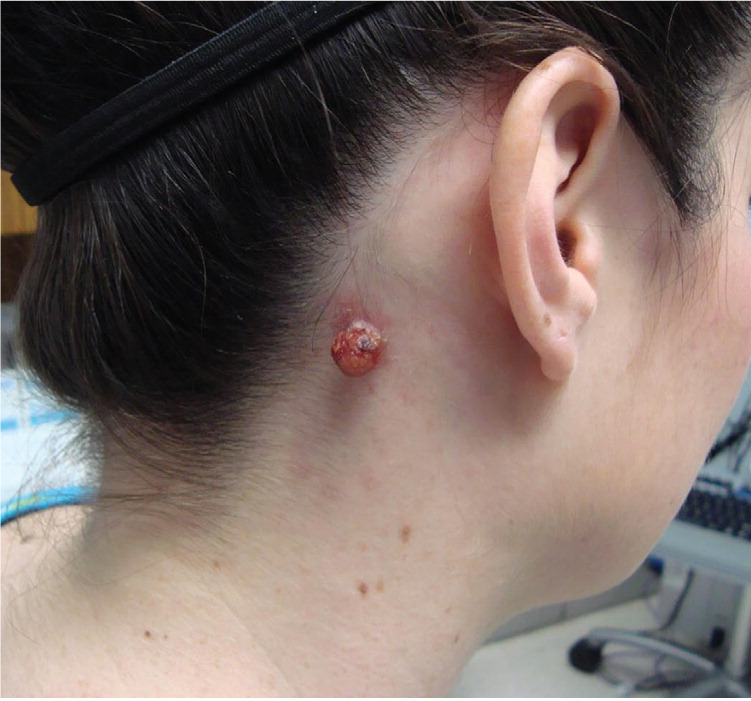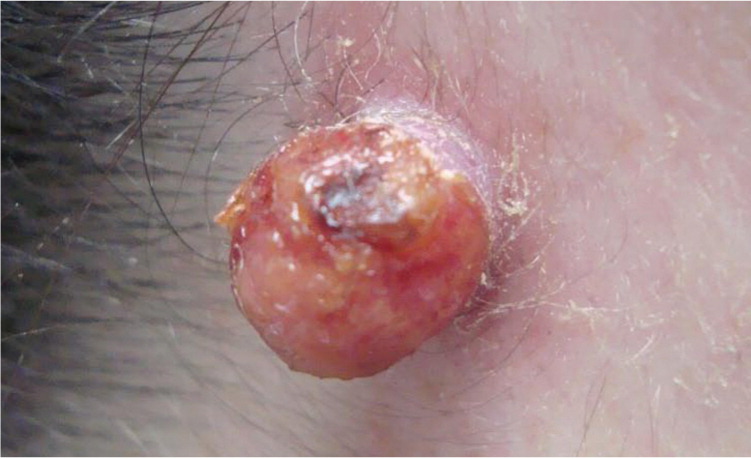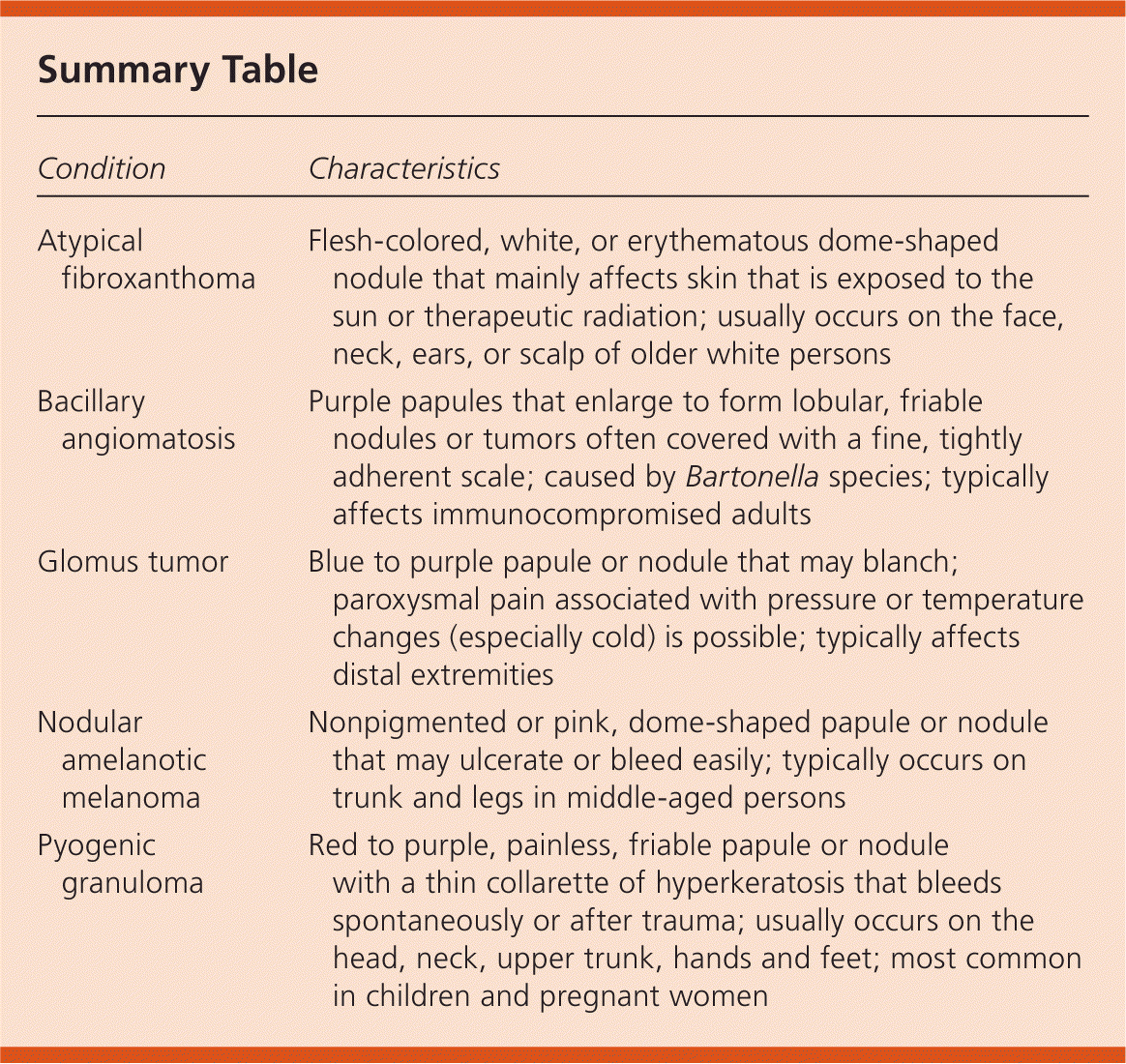
Am Fam Physician. 2011;83(9):1091-1092
Author disclosure: Nothing to disclose.
A 23-year-old woman presented to her primary care physician eight days postpartum because of a polypoid skin nodule behind the patient's right ear. She had first noticed the nodule two months prior. The nodule initially had grown quickly, but it had not changed in size in the previous month. It was not painful, but bled easily. The patient had no history of similar lesions, trauma to the area, or other significant dermatologic history. She was otherwise healthy. Physical examination showed an erythematous, dome-shaped nodule measuring 1.2 cm × 1.2 cm with a moist, friable surface and slight scale around the base (Figures 1 and 2).


Question
Discussion
The answer is E: pyogenic granuloma. This is a relatively common benign, vascular tumor. It typically manifests as a solitary, red to purple, painless, friable papule or nodule with a thin collarette of hyperkeratosis that bleeds spontaneously or after trauma. The tumor commonly occurs on the head, neck, upper trunk, hands, and feet. It grows rapidly over a few weeks and typically does not exceed 2 cm. The etiology of pyogenic granuloma is unclear, but trauma, infection, microscopic arteriovenous malformations, certain medications, cytogenetic clonal deletion abnormalities, and elevated hormone levels in pregnancy are possible causes.1 Women are more often affected because of an increased risk during pregnancy. The condition is also common in children, with prevalence decreasing linearly with age.
Pyogenic granulomas occur in up to 5 percent of pregnant women.1 They may be associated with elevated hormone levels during pregnancy, which can cause the expression of angiogenic factors in inflamed tissues and vascular endothelium or the extension of angiogenic effects by decreasing apoptosis of granuloma cells.1,2 Pyogenic granulomas presenting during pregnancy typically appear during the second or third trimester and often occur on oral tissue; however, nonoral tissue also may be affected.1
Although the diagnosis of pyogenic granulomas is usually clinical, biopsy can confirm an unclear diagnosis. Histologically, the tumor is a lobular, capillary hemangioma with each lobule separated by a fibrous connective tissue septum. The overlying epidermis often shows inward growth at the base of the tumor causing a pedunculated or “cuffed” appearance with surface ulceration.3–5
An atypical fibroxanthoma is a flesh-colored, white, or erythematous dome-shaped nodule that mainly affects skin that is exposed to the sun or therapeutic forms of radiation. Lesions grow quickly and usually occur on the face, neck, ears, or scalp of older white persons. Many patients with atypical fibroxanthomas have a history of nonmelanoma skin cancers.
Bacillary angiomatosis is characterized by one or more purple papules that enlarge to form lobular, friable nodules or tumors often covered with a fine, tightly adherent scale. It is caused by infection with the gram-negative Bartonella species, which may be transmitted through scratches or from cat or arthropod bites. Systemic symptoms, such as fever, weight loss, and lymphadenopathy, are common. Bacillary angiomatosis has been associated with immunosuppression.
A glomus tumor is a benign neoplasm caused by proliferation of glomus cells in the dermis. It is characterized by a blue to purple papule or nodule that usually affects the distal extremities. Other findings include blanching and paroxysmal pain that is often associated with pressure or temperature changes (especially cold).
Nodular amelanotic melanoma is characterized by a slow-growing, nonpigmented or pink, dome-shaped papule or nodule that may ulcerate or bleed easily. It typically occurs on the trunk and legs in middle-aged persons. Because it is the most aggressive subtype of melanoma, it must be distinguished from pyogenic granuloma.

| Condition | Characteristics |
|---|---|
| Atypical fibroxanthoma | Flesh-colored, white, or erythematous dome-shaped nodule that mainly affects skin that is exposed to the sun or therapeutic radiation; usually occurs on the face, neck, ears, or scalp of older white persons |
| Bacillary angiomatosis | Purple papules that enlarge to form lobular, friable nodules or tumors often covered with a fine, tightly adherent scale; caused by Bartonella species; typically affects immunocompromised adults |
| Glomus tumor | Blue to purple papule or nodule that may blanch; paroxysmal pain associated with pressure or temperature changes (especially cold) is possible; typically affects distal extremities |
| Nodular amelanotic melanoma | Nonpigmented or pink, dome-shaped papule or nodule that may ulcerate or bleed easily; typically occurs on trunk and legs in middle-aged persons |
| Pyogenic granuloma | Red to purple, painless, friable papule or nodule with a thin collarette of hyperkeratosis that bleeds spontaneously or after trauma; usually occurs on the head, neck, upper trunk, hands and feet; most common in children and pregnant women |
